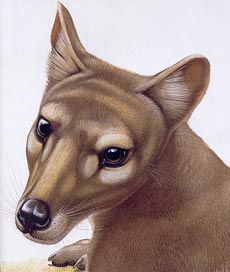Gap in Nature
Air Date: Week of June 6, 2003
As part of our occasional series “A Gap in Nature,” author Tim Flannery chronicles the rise and fall of a marsupial hunter called the thylacine.
Transcript
CURWOOD: These days, we don’t think of marsupials, such as kangaroos and koala bears, as predators. But hunters did once exist among the marsupials, and the largest of these animals to have survived into modern times was the Thylacine. As part of our continuing series, “A Gap in Nature,” author Tim Flannery chronicles the rise and fall of this rather strange creature from down under.
 (Illustration: Peter Schouten) (Illustration: Peter Schouten) |
FLANNERY: About the size and shape of a German shepherd, with a tiger-striped back and hindquarters, the Thylacine is a striking animal. By the time Europeans encountered it in the nineteenth century, its line was limited to the Australian island of Tasmania-- hence its nickname, the Tasmanian tiger or Tasmanian wolf. Thylacines often built their dens among rocks, and the young stayed with their mothers until they were almost fully grown. They hunted alone, in pairs, and in family groups, pursuing wallabies and other animals by scent. They either ambushed their prey or ran them into exhaustion.
In either case, the Thylacine dispatched its victim by crushing its skull in jaws that could open remarkably wide. As for those who hunted the Thylacine, Aborigines occasionally pursued them, but seem to have held them in respect. They built a curious shelter over the Thylacines’ bones, in the belief that if they were rained upon, bad weather was certain to follow. But it was European settlers who relentlessly persecuted the Thylacine into extinction, since sheep farmers saw them as a threat. So a bounty was paid on Thylacine scalps. As live animals became increasingly rare, dead ones commanded ever higher prices. In a move that was far too little, too late, the species was finally protected by the Australian government in 1936, the year that the last known living individual died. That animal was a large female Thylacine kept in the Tasmanian Zoo. When personnel problems developed there, the zoo animals were neglected. As one witness put it, the last Thylacine was left exposed by staying out in an open, wire-topped cage with no access to a sheltered den. In September that year, daytime temperatures soared above 100 degrees, while at night they plummeted to below freezing. On September seventh, the stress became too much for the last Thylacine, and unattended by her keepers, she closed her eyes on the world for the last time. However, it’s possible that a few wild individuals roamed the island for a decade or two after this, for there were a few credible sightings into at least the 1940s. One old hunter said that he found a female and three cubs in an area that was later flooded to create a hydroelectric power plant. When pressed on whether he felt they killed the Thylacine, the hunter dodged the issue, but it’s thought they probably did. Now all hope is lost, for although many expensive searches have been made, no Thylacine sightings have been authenticated for many years. Some hope to recreate the Thylacine from DNA taken from museum specimens. But given our knowledge of molecular biology, this is just a pipe dream. CURWOOD: Tim Flannery is author of “A Gap in Nature: Discovering the World’s Extinct Animals.” To see pictures of the last Thylacine and to hear other segments in our series go to our website, livingonearth.org. That’s livingonearth.org. Links
|





